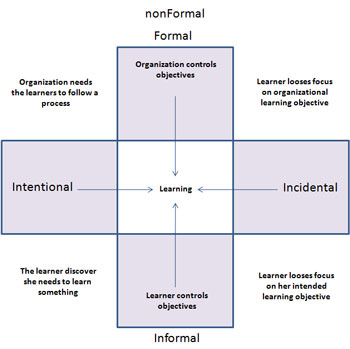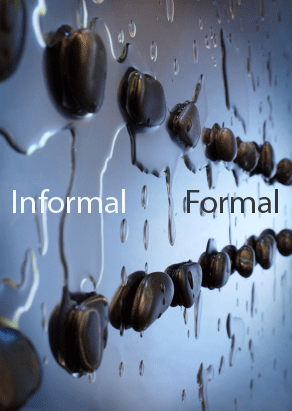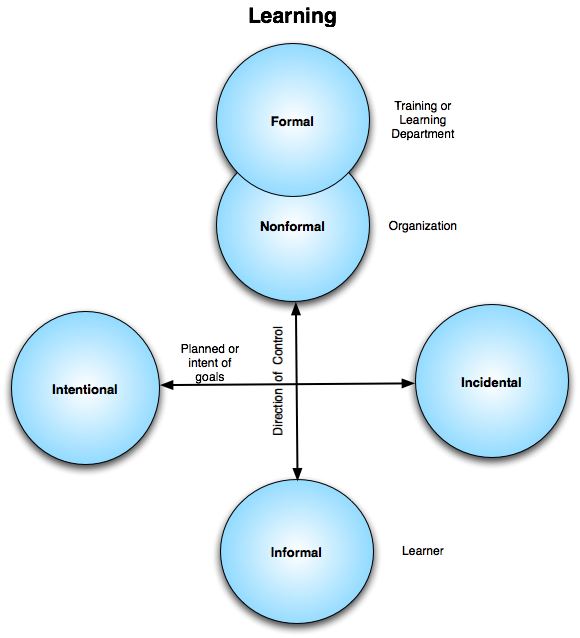Formal & Informal Learning
Malcolm Knowles is generally considered to be the originator of the term “informal learning” through his book published in 1970: Informal Adult Education: A Guide for Administrators, Leaders, and Teachers. Allen Tough was probably the first to really study how adults use informal learning. You can read one of his papers (PDF) here, Reflections on the study of adult learning (1999). The next big proponent of informal learning was Jay Cross, who wrote Informal Learning: Rediscovering the Natural Pathways That Inspire Innovation and Performance (2007).The terms formal and informal learning have nothing to do with the formality of the learning, but rather with the direction of who controls the learning objectives and goals. In a formal learning environment the training or learning department sets the goals and objectives, while informal learning means the learner sets the goals and objective (Cofer, 2000).
In addition, if the organization (other than the training department) sets the learning goals and objectives, such as a line manager directing OJT, then it is normally referred to as “nonformal learning” (Hanley, 2008). Thus, in a formal learning episode, learning specialists or trainers set the goals, while a nonformal episode has someone outside of the learning department, such as a manager or supervisor, setting the goals or objectives.

While incidental learning is often dismissed by trainers, it is an important concept because it often has a motivating effect with the learners that leads to “discovery” learning. So unless other considerations prevent it, it can be worthwhile to detour from the primary objectives to take advantage of an unplanned teachable or trainable moment. For example, if I'm instructing the learners to operate forklifts and we are discussing safety concepts, one or more of the learners might become interested in a safety concept that is unrelated to the operation of forklifts. However, if possible I should try to help them with the unrelated concept, which in turn should help to motivate them with the related safety concepts pertaining to forklifts. In addition it could lead one or more of them to become more interested in the safety program and perhaps lead them to become more involved with it.
Formal and informal learning should also not be thought of as completely distinct entities, but rather as being part of a continuum:

The formal and informal learning chart may also may also be graphed as:

 Bell (1977) used the metaphor of brick and mortar to describe the relationship of formal and informal learning. Formal learning acts as bricks fused into the emerging bridge of personal growth. Informal learning acts as the mortar, facilitating the acceptance and development of the formal learning. He noted that informal learning should NOT replace formal learning activities as it is this synergy that produces effective growth.
Bell (1977) used the metaphor of brick and mortar to describe the relationship of formal and informal learning. Formal learning acts as bricks fused into the emerging bridge of personal growth. Informal learning acts as the mortar, facilitating the acceptance and development of the formal learning. He noted that informal learning should NOT replace formal learning activities as it is this synergy that produces effective growth. And of course the opposite also occurs in that episodes of informal learning often leads to formal learning. In addition, some learning episodes that are strictly informal may be too narrowly based in that the learner only learns part of a task or superficial skills that may not be transferable to the job (Bell and Dale 1999).
Next Steps
Read The True Cost of informal Learning or any of the other sections:References
Bell, C. R. Informal Learning in Organizations. Personnel Journal, 56, no. 6 (June 1977): 280-283, 313. (EJ 160 136)Bell, J., and Dale, M. (1999) Informal Learning in the Workplace. Department for Education and Employment Research Report No. 134. London, England: Department for Education and Employment, August 1999.
Cofer, D. (2000). Informal Workplace Learning. Practice Application Brief. NO 10. U.S. Department of Education: Clearinghouse on Adult, Career, and Vocational Education.
Good, T. & Brophy, J. (1990). Educational Psychology: A realistic approach. New York: Holt, Rinehart, & Winston.
Hanley M. (2008). Introduction to Non-formal Learning. E-Learning Curve Blog. Retrieved October 19, 2009: http://michaelhanley.ie/elearningcurve/introduction-to-non-formal-learning-2/2008/01/28

No comments:
Post a Comment